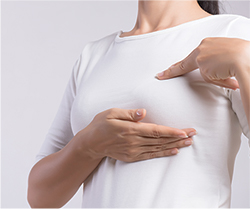When is a Breast Lump Serious?

Finding a lump in your breast can understandably cause worry and anxiety. Dr Tan Yia Swam, consultant breast surgeon at Mount Alvernia Hospital, has answers to your questions about breast lumps, as well as advice for breast screening.
If you’ve ever felt a lump — or what you assume to be a lump — in your breast, your mind might jump straight to the worst case scenario. Whilst a breast lump does warrant further evaluation, don’t resort to panic if you feel one! Many lumps are benign and don’t necessarily indicate a cancerous growth. Here’s a guide on what exactly breast lumps are and what to do if you find one.
What are breast lumps?
There are many different types of cells in the breast, including milk ducts, fat, fibrous tissue, muscle layer, bone in the rib cage, skin and sweat glands. Each and any of these can potentially grow a lump. Many of these lumps are non-cancerous, reassures Dr Tan.
Why do breast lumps occur and what are the different types?
Lumps may occur due to hormonal changes such as fibrocystic breast changes which lead to the formation of fluid-filled round or oval sacs, called cysts. The cysts can make breasts feel tender and lumpy.
Other types of non-cancerous lumps include fibroadenomas (benign breast tumours made up of both glandular and stromal tissues), lipomas (benign tumours of fatty tissue). and angiomyolipomas (benign tumours of fat and muscle tissue that are usually found in the kidney).
What to do if you feel a lump?
“If you examine yourself and feel a breast lump, don’t panic,” assures Dr Tan. “Book an appointment to see a doctor, and let the doctor recommend the necessary check to confirm what it is.” This will usually be a radiology study, depending on your age. Some women may also need a biopsy for diagnosis.
The importance of breast screening
“Screening for illness refers to the process of identifying a very early stage of the disease process, such that the disease may be prevented or cured,” explains Dr Tan. “Tests that are used for screening have been rigorously studied to make sure that they are user-friendly, accurate and cost effective.
For women, there are effective screening tests for breast cancers. For breast cancer screening, most countries, including Singapore, recommend mammogram screening from age 50 onwards. For ladies who are at higher risk, this may start at age 40. Some specialists will recommend a supplementary ultrasound as well. “Screening tests can help to pick up breast cancer at an early stage, even stage 0,” notes Dr Tan. “The earlier the stage at which it is detected, the better the prognosis and survival.”
Should I go for an ultrasound or mammogram?
As ultrasounds and mammograms study different things, Dr Tan advises that women aged 40 or older can consider yearly mammogram screenings, with a supplementary ultrasound. For younger women, a monthly breast self- examination starting from age 18 is a good way to know your body well, and be alert if anything new develops. “However, do bear in mind that most lumps detected are non-cancerous,” reminds Dr Tan.
What are the different types of breast screening?
Mammogram: A mammogram uses X-rays to detect calcium spots in the breasts — which may be a sign of early cancer. Calcium spots may also be due to many other non-cancerous causes. This should not be done during pregnancy or breastfeeding.
During the X-ray, a radiographer will place your breast between two flat plastic plates and compress it for a few seconds. This is performed on one breast at a time. There may some discomfort but it is important for the breast tissue to be compressed for a clearer image. Additional views may be needed for close examination. Talk to your breast specialist at the clinic review to understand the findings.
Ultrasound: This technology, also used for monitoring the baby during pregnancy, safe for detecting lumps. It helps determine if a lump is solid or cystic (filled with fluid). While ultrasound is not typically used as a screening method because most lumps detected are non-cancerous, it can be valuable for identifying potential issues. However, cancerous lumps found through ultrasound might be at a more advanced stage compared to those detected by mammograms.
For patients with a high risk of breast cancer, specialists may recommend other methods such as:
- A breast MRI (for selected high risk individuals)
- Biopsy (for abnormal findings on radiology)
- Genetic screening (for selected individuals)
“There are pros and cons for each method, so do speak to a breast doctor to understand what you need,” says Dr Tan.
Article contributed by Dr Tan Yia Swam, accredited doctor from Mount Alvernia Hospital.
Mount Alvernia Hospital’s Health Screening Centre offers various health screening packages that include breast screening. You can call 6347 6215, Whatsapp 9819 1303 or email [email protected] to find out more.
This article is taken from our MyAlvernia Magazine Issue #50. Click here to read the issue on our website.
